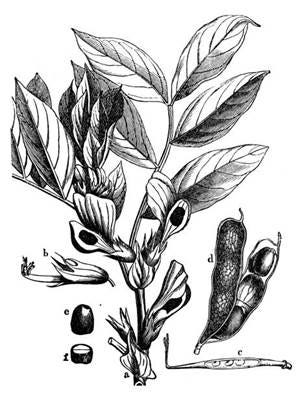Especially for the Sicilians, the fava bean means good luck. They are laid on alters on St Joseph’s Day, given out as talismans, and places on shelves so that the pantry is never empty. Planting fava beans on Good Friday brings good luck, yet dreaming about them means that conflict looms. Harvested yearly, the vicia fava can be eaten raw or cooked. Greeks, Italians, Turks and Arabs are especially enamored of them. The plant’s flowers are white, though its wing petals have some black. The rare crimson-flowered fava bean was recently saved from extinction—which is very fortunate.
The bean was cultivated as far back as the Neolithic. Radiocarbon remains have been found in Palestine from agricultural works at the El Wad Terrace, the land where Joseph the Carpenter was later born. English has many names for them: horse beans, field beans, broad beans. Their popularity as food was not universal, however. Pythagoras decreed that we should not eat them because they were receptacles for reincarnated souls, making the bean-eater a de facto cannibal. Uncooked fava beans can cause Glucose-6-phosphate dehydrogenase deficiency, or Favism, a breakdown of red blood cells which may prove fatal [1]. Perhaps these are the vengeful spirits Pythagoras talked about.
In Attic Greece, fava beans were used for tallying votes. White and black beans were cast, yay or nay (which is where being blackballed comes from). The Ubykh people tossed them on the ground to be read in divination. Bogart’s phrase of single lives not being worth a hill of beans in a crazy world refers to the bean’s worldwide role as staple of peasant diet. Fava beans are common and worthless, not as colorful as more exotic foods. Yet it must be remembered that a lucky object is always worthless, even though it saves lives and gives prosperity. Or vice versa: an old Muslim legend tells that Solomon’s magic ring ended up on the finger of a drunken bum who died of hunger in an alley. Which is very bad luck. But the real point here is that some things are so precious they cannot be sold, so priceless that they can have no value, so extraordinary that most people pass them by.
The Romans offered the fave dei morti to the dead during the feast of Lemuria, an annual exorcism aimed at placating the lemures or larvae, wandering evil spirits who harassed the living. Beans are still sown on All Souls’ Day in parts of Italy, baked into cakes, made into soup. In Liguria, they are eaten raw with a little sausage. On the Saint’s feast day, they can be cooked into a frittata or served up in garlic sauce. Dried, roasted, and blessed, they undergo their own martyrdom. In Sicily, so the legend goes, fava beans were used for cattle fodder and so during a famine, hunger drove the farmers to subsist on them. After beseeching St Joseph, and eating a lot of beans, it rained and the crops revived. This is why beans are handed out on St Joseph’s Day for good luck and a healthy harvest. Fava beans have many uses, from the sacred to the profane. The Roman sage Pliny the Elder noted that they made a fine laxative. But it was volcanic gases that killed him when he visited Mount Vesuvius on the wrong day. Portly and overstuffed, this great father of the sciences mistook his stomach’s rumbling for the rumbling in the hills.
By the 10th century, March 19 was dedicated to St Joseph on a number of Western calendars. It took Rome until 1479 to make it official. In the Roman Rite, the history of St Joseph’s Day, with its various precepts and Solemnities and promotions, double and second-classes is a labyrinth for the uninitiated. The feast’s date has always been troubled by its proximity to Lent. Luckily, it can be moved if necessary, especially if you are Episcopal. An additional St Joseph’s Day was celebrated between 1870-1955 but abolished by Pope Pius XII. He later added another St Joseph’s feast day, this time on May 1, to compete with International Workers’ Day in Catholic countries behind the Iron Curtain. The not very subtly-titled Feast of Saint Joseph The Worker has subsequently been reduced to an optional since the end of the Cold War. But as red is considered sacred to St Joseph, he may indeed have been a good communist. Breadcrumbs are scattered on the ground to commemorate the sawdust on this sacred tradesman’s shop floor. Joseph’s capitalist bosses used timber to build luxury homes for the rich and to crucify criminals.
Thus, we can see a common theme in the fava bean: transference, motion, displacement, revolution. It is a moveable crop; the souls of the dead transmigrate into them; St Joseph, a homeless refugee, was constantly on the move; its day and rank have shifted within the Catholic liturgical calendar; the bean bounces around rapidly when being boiled; after being consumed, it passes through the digestive system. The fava bean is constantly moving, restless and given to transformation, a magical thing that is also very much of the earth. Carried as a good luck charm, it never fails to protect the traveler when he embarks on a great journey.
It is also believed that the beanstalk Jack climbed was a fava plant.
[1] Strangely, if you contract Favism, the potentially fatal disease wards off malaria. So this bean-born disease and its pathogens can also preserve life.







Now I know what I am doing for St. Joseph's day?
I just planted my favas. She is one strange looking, delicious plant. This is a great piece.